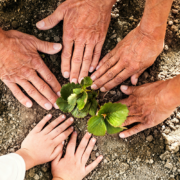Community Social Networks and Indigenous Resilience to Climate Change
Strong social networks play an important role in sustaining an Indigenous community’s resilience to climate change. The term social capital is used to explain the ties that connect a community together through common identity, like kinship ties (i.e., bonding), and the ways in which one community builds a connection with another, beyond shared identity (i.e., bridging). Social capital is characterized by “levels of trust” and by how people are able to secure and transfer resources and benefits of social capital through their engagement with each other’s different social connections.
Social capital is enhanced by community resilience and is threatened by community vulnerabilities. However, communities experience both resilience and vulnerability to climate and environmental changes, simultaneously. Vulnerability among Indigenous communities is created by processes that undermine Indigenous knowledge systems, that promote landscape fragmentation and land dispossession, and that threaten Indigenous rights and sovereignty, on top of the rapid pace of environmental change. In some Indigenous pastoral environments, as in arid and semi-arid regions in Kenya, gender, age, education, disability, are contributing factors to climate change vulnerability. Resilience is enhanced through connecting and learning from the land and exchanging knowledge about the land through social networks, especially in smaller communities.
As documented among Canada’s Northern Indigenous communities, when social networks are strong, there is less dependence on government policies and on infrastructure, to deal with the various “environmental stressors” associated with climate change. A criticism of Canadian policy is that it does not recognize differences between how Indigenous communities in Northern regions adapt to climate change compared to those communities located in Southern regions. Geographically isolated communities in Northern Canada depend heavily on social networks and traditional knowledge. Currently, social capital is not included in Canada’s overall policy approach to climate change adaptation. Government policy on climate change should incorporate factors like food security and resource distribution, which are key benefits of social networks.
Indigenous communities benefit from social capital through collective action to fight climate change. Collective action and is supported through acts of solidarity and practices of sharing and reciprocity. Sharing can include exchanges of food, offering shelter, different kinds of social support, and labour; it can also involve the sharing of risks. The impact of collective action varies in relation to power differences among group members or across different communities that work together. Collective action is affected by power relations in decision making, and so it may not always lead to community resilience. Ideally, collective action promotes flexibility, shared leadership, and exchanges of innovative adaptations to climate change.
How Indigenous communities draw from social networks to address the immediate impacts of climate change on their communities, and to adapt to climate change over time, needs further exploration. Ultimately, social capital is a crucial component to Indigenous climate change adaptation and it should be taken more seriously by climate change policy makers, in order to better understand and address, the vulnerability and the overall resilience of Indigenous communities to climate change.
By Leela Viswanathan
(Photo Credit: Ricardo Gomez Angel)





